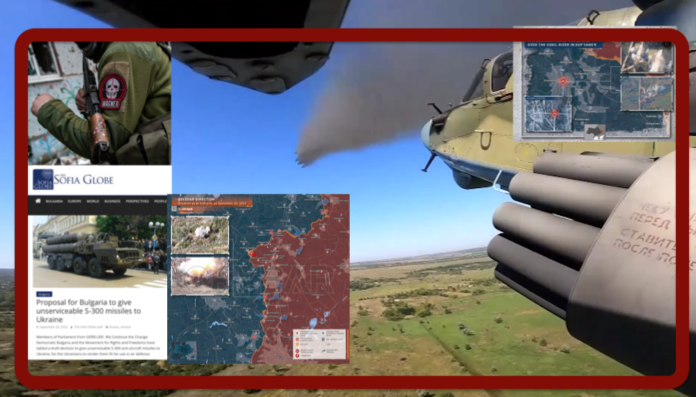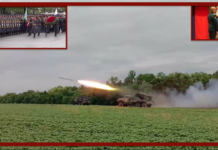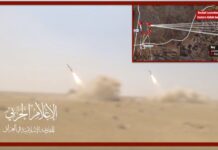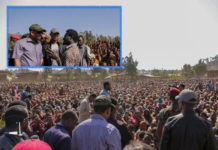
According to the Western mainstream press, the attack on the General Command of the Russian Black Sea Fleet would have caused an excellent victim: the commander of the Fleet, Admiral Viktor Sokolov. In this way we would like to certify the effectiveness of the attack itself on an undoubtedly military objective. But the propaganda hoax, or classic Infowar, is around the corner. On September 26, the Russian Defense Ministry released a video showing the commander of the Black Sea Fleet, Viktor Sokolov, attending a meeting of the Ministry’s board.
The Abrams have arrived in Ukraine. Russia has criticized the delivery of the first batch of American M1 Abrams tanks to Ukraine. Kremlin spokesman Dmitry Peskov said the tanks would not influence the outcome of the war in any way: “There is no panacea and there is no single type of weapon that can change the balance of forces on the battlefield.” While he acknowledged that the Abrams tanks are serious weapons, he warned that they would burn like other weapons already sent. Peskov accused the United States of increasing “its indirect participation in this conflict.” Ukrainian President Volodimyr Zelensky confirmed the tanks’ arrival, calling it a significant reinforcement. In total, the US plans to deliver 31 of the latest tanks, with deliveries expected to be completed in the coming weeks.
However, according to what The Washington Post reports, to date, less than half of the total number of planned M1 Abrams tanks has arrived in Ukraine; WP cites an unspecified senior Ukrainian military official as its source. According to what The Wall Street Journal later states, Ukrainian officials admit that the arrival of the American Abrams tanks is unlikely to significantly change the course of the conflict. US Department of Defense officials have repeatedly warned that no weapons system will change the course of combat due to its complexity. As the autumn rains approach, the ground will quickly become wet. Furthermore, when Ukraine used German Leopard IIs and American armored vehicles, they became a prime target for the Russians. Recently, in an interview, the head of the Main Intelligence Directorate of the Ministry of Defense of Ukraine, Kirill Budanov, said that now heavily armored vehicles are used mainly for transporting soldiers and practically do not take part in combat operations. According to former British general Ben Barry, the Abrams will have some impact and provide many advantages, especially compared to the Leopard 1s received from Ukraine. However, according to him, it will be more difficult for Ukrainians to maintain and repair them.
Kiev is about to receive ATACMS missiles and the secretary of the National Security and Defense Council of Ukraine, Alexey Danilov, has expressed his opinion on this. “The Ukrainian Armed Forces will not use ATACMS tactical missiles to launch attacks on Russian territory,” Danilov said, in an interview with Spanish ABC.
But the most interesting news on the September 26 front is that of the return of the WAGNER PMC to the Northern Military District area.
The first PMC units began to return to Bakhmut to carry out a counterattack on previously lost positions: this is, officially, that part of the Company that broke away from the main forces of the PMC in the circus day of Yevgeny Prigozhin’s “rebellion”.
The nucleus is made up of fighters from the PMC “Redut” of the Ministry of Defense and the “Volunteer Corps”, which includes only former WAGNER PMC units. In parallel with this, a campaign continues to be conducted among the fighters of the PMCs involved in the Belarusian and African-Middle Eastern directions.
As for the main part of the PMC, the command of the PMC in the person of Lotus conducted negotiations with the Russian Guard regarding the inclusion of the detachments under their umbrella. But one of the main conditions is the signing of individual contracts with military personnel. And these will no longer be soldiers of the Company, but full-time soldiers, who can be divided, sent in other directions and dealt with according to the needs and in the interests of law enforcement. In words, the Russian Guard has promised not to allow this to happen, to allow the preservation of flags, ranks and insignia, but de jure this will not be sanctioned in any way.
This is why the issue of joining the Russian Guard has not yet been resolved: at the council of PMC commanders on September 22, no unanimous decision on this issue was made. Maybe some fighters will accept such conditions, but certainly not all.
Logistical problems remain. The command of the Russian Armed Forces at the Khmeimim air base strongly recommended to the Syrians not to allow the landing of planes from Libya, the Central African Republic and Mali, and they listened to the recommendations. Therefore, most likely, the logistics of the PMC will be revised, which will further increase the gap between the Ministry of Defense and the Company.
Meanwhile in Sofia, a project on the transfer of unusable S-300 air defense systems to Ukrainian formations was presented to the Bulgarian parliament. The explanatory note directly states that Kiev is willing to accept vehicles along with defective ammunition.
Of the 10 launchers delivered in Soviet times, only a few are actually combat-ready and their ammunition is in short supply.
By sending these vehicles to Ukraine, Sofia will solve several problems at once: it will save itself from the need to dispose of expired products and at the same time receive reasons to demand “compensation” from other NATO countries in the form of other types of weapons.
The day of September 25 on the fronts can be summarized in several points: Russian troops attacked the military structures in the Ukrainian rear. In the Dnipro region, Dolgintsevo airport, where tactical aviation and an ammunition depot are based, was hit during the attack; Russian missiles hit military facilities in the Odessa region. Ukrainian units continue to shell the border areas of the Belgorod region; reported Ukrainian missile attack on Krasnodon in Lugansk People’s Republic. In the direction of Soledar, fighting continued in the Klishchiivka area; the Russians continued to carry out regular airstrikes on the positions of Ukrainian units near Vuhledar. In the Orikhiv sector the Ukrainians attack in the Robotyno area with heavy losses; near Verbove other Kiev attacks repelled by the Russians.
The front line looked like this at 12pm on September 26th.
In the morning the missile alert was raised in Ukraine; attack in Krivoy Rog with Russian Geran in the Cherkasy region, and in the port of Reni in the Odessa region, which is now a large hub and literally full of containers with trucks. Russian UAVs also hit the Orlovka-Isakcha ferry crossing, suspending the operation of the Orlovka checkpoint. Ukrainian air defense operational in the Nikolaev region; attack by Russian UAVs on the Kulbakino airfield, which destroyed at least one MiG-29 fighter. This is the third recorded case of Ukrainian Air Force aircraft of this type being hit on the ground in recent days.
On the Zaporozhye front, the enemy rotates units near the combat contact line, conducts reconnaissance in force, sending patrols.
In the Kherson region, the Russian air force is increasing the number of attacks on the Ukrainian side of the Dnieper.
In the Avdeevsky direction, the Russian Armed Forces carried out offensive operations near Opytny, capturing several strongholds.
More Ukrainian attacks on Crimea and Sevastopol with Storm Shadow missiles. Drone raids in the Kursk and Belgorod regions are becoming massive. In the Belgorod region, 7 UAVs were shot down; in the Kursk region the Ukrainians launched drones throughout the day: the last one was shot down around 5.30 am, Russian sources report.
The situation at 5pm on 26 September was then defined in this way: possible attack by the Ukrainian armed forces in Bakhmut in the direction of Soledar. where the situation remains practically without significant changes: there is a struggle of position with the mutual use of weapons, from artillery and aviation to FPV drones. Russian paratroopers carried out an attack on Kiev positions in the Orekhovo-Vasilevka area.
On the southern flank, the front line on the Kleshcheevka – Andreevka – Kurdyumovka line also does not present significant changes. From time to time, the Ukrainian Armed Forces attempt to attack Russian positions in small groups, but without success.
Units of the Armed Forces of Ukraine are concentrated in the rear in the direction of Bakhmut. If you look at the areas in which they are concentrated, possible directions of attack emerge: Razdolovka and Lisichansk, as well as Zaitsevo – Kodema.
Furthermore, the main task is to cover Bakhmut, and the attacks on Lisichansk and Kodema most likely diversions.
Ukrainians continue to bomb the Kursk region.
In the village of Snagost, Korenevsky District, a UAV of the Ukrainian Armed Forces attacked a substation, seven nearby settlements were cut off from the electric grid. The village of Popovo-Lezhachi, Glushkovsky district was also hit. Attacks also on the village of Tetkino.
The Oskol Bridge in Kupyansk destroyed by the Russians. The Russians launched an attack with an X-38 guided missile against Ukrainian armed forces crossing the Oskol River in Kupyansk. The shot hit and the bridge collapsed. As a result, it is currently impossible to supply the group near Kupyansk through this pass.
Graziella Giangiulio e Antonio Albanese
















